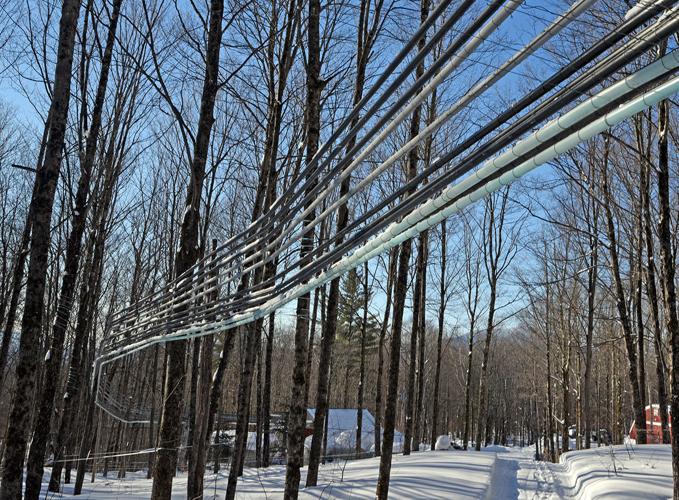March is just around the corner: a month long-awaited not only for the signs of spring it brings, but also for the liquid gold that’s about to start flowing in force across the Green Mountain State.
But making maple sap into delicious maple syrup isn’t simply a matter of firing up the arch once the temperature crests above freezing and the sap starts to really flow. Vermont’s maple sugar makers spend months preparing and working to be ready for a money-making season that runs for a few months at most, or could be over in a matter of weeks.
The five-person crew at Butternut Mountain Farm in Johnson works year-round in the 25,000-tap sugarbush there, but things really ramp up around the New Year, which is when all five of them start tapping the trees — a job that takes more than a month.

While the main sap lines running to the sugarhouse are left up in the woods all year, every one of those 25,000 taps is pulled out after the last boil each spring. So come January, every tree must be tapped again, a process that includes drilling a new hole, tapping in a new spout and connecting new feeder line from each tree to the main lines.
“We tap every tree, every year,” Butternut crew member Doug Cross said. Those new taps don’t simply go right next to where the old one was pulled, either.
“It’s vital for tree health and also production to stay away from old tap holes and not use the same section of tree year after year,” said Robin Pierson, who owns and operates Stowe Maple Products with her husband Steven.
When done right, placing each year’s new tap far enough away from the older ones lets the tree heal and continue to grow and produce sap year after year.
According to the Vermont Maple Sugar Makers’ Association, a sugar maple tree (Acer saccharum) that is 10 to 12 inches in diameter at chest height is about 40 years old, and gets a single tap. Some large Vermont maple trees are more than 200 years old.
Every sugar maker has a different system they use when deciding where exactly to put a new tap. At Butternut, the crew looks to place the new hole six inches to the left or right and 12 inches above or below last year’s tap.

Doug Cross and Patrick Start
Cross and the rest of the Butternut crew started that work on Jan. 6 this year; more and more sugar makers are starting to tap that early, especially the large operations that have sprung up all over the state in the last decade.
“It’s gotten earlier and earlier as we’ve expanded,” said Ira Marvin, who co-owns both the Butternut Mountain Farm sugarhouse and the maple sugar company of the same name in Morrisville with his sister Emma and parents, David and Lucy.
Sugar makers used to start much later in the winter — the old rule of thumb used to be tapping by Town Meeting Day, Pierson said, but now, you’re likely to miss a significant run if you wait until March.
“Now, we’re usually tapping by the first of February,” she said.
The Piersons have a smaller operation — about 8,000 taps spread out over four sugarbushes — but Steve is a one-man tapping operation, so starting on time is key.
“It’s not possible to make up at the end of the season what you miss at the beginning,” Pierson said.
Gearing up
For most sugar makers, a day spent out tapping means you’re miles out in the woods; Butternut’s farthest taps are 2 and a half miles from the sugarhouse near the top of Butternut Mountain, within shouting distance of the nearby Long Trail.
The Piersons’ sugarbush near the Pinnacle in Stowe is also extremely isolated, so “making sure you’re appropriately dressed for the weather,” is critical, Pierson said. Once you’re out for the day, you don’t usually come back, so everything you’re going to use — or eat — had better be with you.
“A fully charged drill, spare batteries, all the gear and supplies you need for the entire day,” Pierson said.
Butternut’s crew all have special tool vests made to hold all the gear, tools and parts a sugar maker needs to tap and repair damaged lines. And, they’ve got some machine power to get them where they’re going; snowmobiles, a side-by-side and even an old Jeep Cherokee retrofitted with tracks, which not only helps break trail but also makes a nice, warm spot to have lunch when you’re miles from the sugarhouse. Eventually though, you have to hoof it to each tree to actually tap, so snowshoes are a must.
Along with the standard tapping tools, which include a 20-volt cordless drill and soft mallet, Steve Pierson’s daily equipment can also include chainsaws, come-a-longs, candy-grabbers (pliers), wire joiners and nut drivers, depending on what he’s doing and where he’s doing it.
Pre-season prep and checking lines
Actually tapping the trees is just one of the final steps a sugar maker takes in getting ready for the season. The Piersons really get to work in late October when the leaves have fallen off the trees. They spend the fall assessing tree health, propping or hooking up main lines so they don’t get buried in the coming snow, tweaking main lines to make sure the sap will run right in March, and replacing drop lines to individual trees.
Any damage caused by high winds, falling trees or wild animals is fixed then, too, and the ever-constant battle to replace lines and spouts chewed by squirrels picks up in earnest.
The Butternut Mountain crew also spends their warmer months pulling taps, rebuilding roads that crisscross the sugarbush, and replacing sections of main line.
Even after the tapping is done, the prep work is still not quite finished. If the snow is still falling regularly the main lines can get buried, which can prevent them from thawing after a freeze.
And, once the sap does start to flow someone inevitably must venture out and find that one leak, somewhere among all the lines and thousands of taps, that’s keeping things from running smoothly.
An early start
The earlier start to the tapping season provides two benefits. First, it allows for plenty of make-up days if you can’t get out every day.
The Butternut crew plans to be out every day tapping once they start, but Mother Nature doesn’t always cooperate.
“We don’t tap if it’s below zero (degrees),” Cross said, because doing so can severely injure or kill the tree. There have been plenty of sub-zero days this winter, which, combined with deeper-than-average snow in the woods, has made for slow going.
The Butternut crew averaged about three tapping days per week between early January and early February.
“Usually it’s five or six days a week,” Cross said, which had put them “behind the eight ball,” by Feb. 1, when they still had about a third of their tapping left to do.
The second benefit of that early start is catching any early February or even January runs if it does warm up enough to get some sap flowing. At Butternut, the first taps are set in areas at lower elevations or on south-facing slopes, which get direct sunlight all morning.
“The reality is it might start running at any point. You never know,” Marvin said. “The last thing we want is to not be ready when the season starts.”
The Piersons use a similar strategy.
“We tap four different locations, starting with the early-running south- and west-facing slopes first,” Pierson said.
Butternut had their first boil on Feb. 11, before the crew had even finished tapping some of the colder regions of the sugarbush.
“We made just a little over a drum,” or about 40 gallons, Marvin said. The same thing happened last year, when they were able to catch a mid-February run.
Pierson heard rumor of a few sugar makers in the southern Champlain Valley who boiled even earlier, but Stowe’s always colder, so they don’t rush to tap any earlier.
Marvin said getting that first boil out of the way is always important.
“It’s like riding a bike for the first time again each summer,” Marvin said. “You know how to do it, but it’s nice to do it once and know everything is where it needs to be.”


























(0) comments
Welcome to the discussion.
Log In
Keep it clean. Please avoid obscene, vulgar, lewd, racist or sexual language.
PLEASE TURN OFF YOUR CAPS LOCK.
Don't threaten. Threats of harming another person will not be tolerated.
Be truthful. Don't knowingly lie about anyone or anything.
Be nice. No racism, sexism or any sort of -ism that is degrading to another person.
Be proactive. Use the "Report" link on each comment to let us know of abusive posts.
Share with us. We'd love to hear eyewitness accounts, the history behind an article.